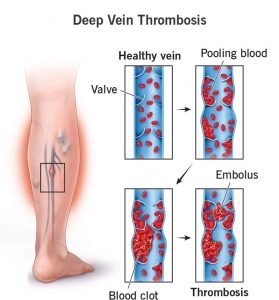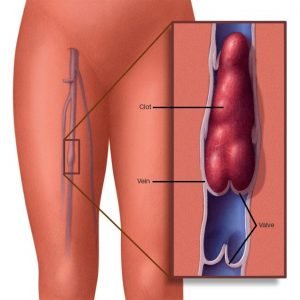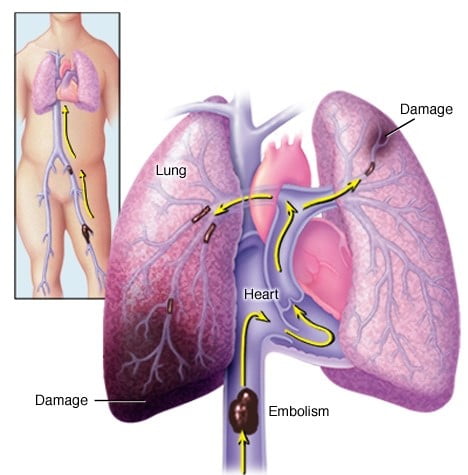Make an Appointment Now
info@macitbitargil.com
Acıbadem Hospitals
Make an Appointment Now
info@macitbitargil.com
Acıbadem Hospitals

While deep vein thrombosis is a preventable disease caused by vessel wall injuries, changes in blood flow and coagulation disorders, there is a life-threatening risk if it is not treated. One of the most important factors in deep vein thrombosis is the deterioration in the coagulation system.
Deep vein thrombosis, which can be defined as the occlusion of the deep vein in the leg with a clot, can be seen due to various reasons. The clot in the deep veins, which cannot be seen from the outside, partially or completely blocks the blood flow, and accordingly, it causes the accumulation of vein blood in the leg. The clot in the veins seen from the outside is called superficial vein thrombosis or phlebitis.
In deep vein thrombosis, which is usually painless, there is a risk that the clot may break off from its location and cause death by obstructing the pulmonary vessels with blood flow. In this emergency, which is called pulmonary embolism, failure to treat immediately can lead to death.
In deep vein thrombosis, rarely, even if the clot dissolves, obstructions and stenoses may form in the vein and cause deterioration of the valves. In this case, the flow of venous blood, which should return from the legs years after the formation of the clot, is increasingly blocked, and it may be possible for the blood to pool in the veins and the pressure to increase.
As a result, high blood pressure in the vein can damage the tissues. Venous insufficiency characterized by swelling, discoloration, pain and sores in the wrist is seen in the leg. Rarely, gangrene may develop due to the deterioration of arterial circulation in the leg, which gradually swells as a result of the clogged vein preventing the discharge of the pooled blood in the leg.
Almost half of patients with deep vein thrombosis do not have any serious symptoms. The most common complaints are leg pain, swelling, tenderness, and purple or bluish leg color, especially when standing. The leg may be warmer than the other leg and the vein may be prominent.
If the clot reaches the lungs, it can cause shortness of breath, cough, chest pain and bloody sputum. Half of the patients with deep vein thrombosis may have pulmonary embolism at the time of diagnosis without serious clinical sympoms. In some cases, lung complaints can lead to death due to severe respiratory failure as one of the leading complaints.
The aforementioned symptoms in patients with risk factors may indicate deep vein thrombosis. The necessity of detailed research on deep vein thrombosis in patients with active cancer disease, in situations requiring prolonged immobility such as hospitalization or long journeys, or in cases of sudden swelling in the leg, pain when pressed on the deep veins, and prominent superficial veins during recent surgical interventions should not be overlooked.
Color Doppler ultrasonography is considered the easiest and most reliable method in the detection of deep vein thrombosis. However, it may not be possible to evaluate the veins in the abdomen and the veins close to the heart and in the thoracic cavity completely with color Doppler.
In such cases, computed tomography and magnetic resonance venography can be used to obtain more reliable information. It is also possible to use these methods for the diagnosis of pulmonary embolism in the same session.
Venography is one of the most reliable methods in the diagnosis of deep vein thrombosis. Venography, which is known as a painful procedure because it is applied through the insertion of a venous catheter, is less applied today due to the improvements provided by other methods. D-dimer measurement can also be used as a laboratory test. Although a normal D-dimer usually means that there is no deep vein thrombosis, elevation of D-dimer in the blood should not always be interpreted as a sign of deep vein thrombosis.
Deep vein thrombosis treatment is mainly applied to prevent pulmonary embolism and re-development of deep vein thrombosis. It is also aimed to reduce the complaint in the patient’s leg and to prevent future problems. Accordingly, anticoagulant treatment and compression stockings can be used.
Taking blood thinning medication (Anticoagulant): These drugs are taken to prevent the progression of the existing clot and the formation of new clots. Heparin and Warfarin or Coumadin treatment are usually started together, as their ability to dissolve the clot is extremely low. Treatment with Coumadin or Warfarin alone is continued according to the result obtained from the INR blood test, which shows the coagulation status.
Since these drugs prevent blood clotting, they can cause bleeding in high doses. Bleeding usually occurs with light bleeding in the urine and then stomach bleeding, and it is a condition that requires urgent hospitalization.
Dissolution of the clot: Although taking blood thinners, as the classical treatment of deep vein thrombosis, protects the patient from pulmonary embolism and significantly reduces the complaints in the leg, the leg does not return to normal since the clot in the leg is not completely dissolved and the obstruction is not cleared. To open the blockage, some special methods should be used, such as dissolving the clot by administering clot-dissolving drugs into the clogged vessels with catheters, or removing the clot with a catheter or surgical method.
When the clot is dissolved, angioplasty may be required to prevent re-occlusion of the opened vessel. These methods, which help to relieve the patient’s complaints significantly or completely, are not applied to every patient due to the risk they carry. In cases where the blood flow in the legs is impaired due to deep vein thrombosis and causes gangrene, these methods can be used to remove the clot in young and active people.
Compression stockings: In this method, which has an important place in the treatment of deep vein thrombosis, compression stockings of 30-40 mmHg and long enough to reach below the knee level should be used. Compression stockings are worn continuously for the first few days and then only during the day. Accordingly, the compression stockings, which are worn without getting out of bed, are removed when going to bed. In the first days of using compression stockings, which should be worn for at least 2 years, it is recommended to raise the legs above the level of the heart in order to reduce the complaints in the legs.
Filter placement: Despite the treatment methods applied, pulmonary embolism may not be prevented. If treatment is unsuccessful, if treatment is not started or interrupted, a filter is placed in the vein to prevent clots to reduce the risk of pulmonary embolism.
The guiding factor in the diagnosis of deep vein thrombosis is the patient’s complaints and accompanying risk factors. Ultrasound, venography and blood tests can be used to confirm the diagnosis.
 Symptoms and Signs of Pulmonary Embolism
Symptoms and Signs of Pulmonary EmbolismIntravascular coagulation in the leg veins is the most common cause of pulmonary embolism. In the presence of predisposing conditions, the risk of developing pulmonary embolism increases with deep vein thrombosis.
The clinical manifestations of pulmonary embolism may vary depending on the size and severity of the vascular occlusion for the patient. Mild embolism may not cause symptoms in patients, since the effect on the vessels may differ depending on the size of the clots reaching the embolism. Congestion from larger emboli can cause further impact on lung tissue. The result of this situation is that the clinical picture begins to become evident.
The symptoms observed in the course of pulmonary embolism can be listed as follows:
To reduce swelling in the legs, it may be beneficial to travel with the knees slightly bent and elevated above the level of the heart. In cases where it is necessary to sit for a long time, the legs should be moved at certain intervals. You can take short walks by getting up every hour while awake. Compression stockings should be used as recommended and clothes that tighten the legs should be avoided.
All content on the website is for informational purposes only. Consult your doctor for diagnosis and treatment methods.
2022 © All Rights reserved | Design & SEO & Development Simur Digital